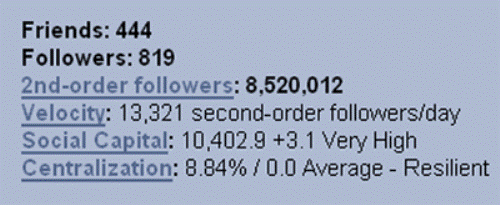How influential are you on Twitter? That’s what several sites are now promising to judge, labeling you by doing everything from calculating your “social capital” to knocking you for a “low Twitter efficiency.”
These Twitter ranking sites vary in how calculations are made-some basic sites rely solely on the number of tweets, retweets and followers, while others use more complicated algorithms to determine results.
Related stories:
How are your users surfing?
Five ways to really get noticed on Twitter
Many Twitter users flock to these sites for an ego boost, or to gauge how they compare with their peers, says Dan Schawbel, a personal branding expert and author of Me 2.0. But these rankings also offer an interesting peek into what you can do to be more present on the microblogging site, he says. Be careful not to focus too much on your rankings, though, Schawbel says. “You will lose the opportunity to build real relationships with people.”
Here are my picks for five useful Twitter ranking sites, and a look at how each one determines your worth, rank and influence. Even if you’re not into rankings, these tools deserve your attention-your peers and potential future employers may use them to judge you.
1. Buzzom.
Buzzom’s statistic feature analyzes your Twitter information and displays a number of charts and graphs depicting your top profile matches and your influence in the Twittersphere. Your “influence” score, for example, is calculated by determining the ratio of number of people you are following to the number of people who are following you (your score is higher if people are willing to follow you even if you don’t follow them back). Your “retweet” score is determined by how often others retweet you, and your “tweet efficiency” score is determined by comparing your tweet rate to your followers-if you tweet often and you have few followers, it deems your tweets “wasted” and you receive a low score. Finally, your overall score (which Buzzom calls the “InRev TwitIn Score”) is calculated by taking all these scores into consideration.

2. Topsy.
Topsy functions primarily as a Twitter search engine, but also categorizes top Twitter users as “influential” or “highly influential” based on a few factors, including: how often you’re cited in tweets and how influential the people are who tweet about you or the links you post. For example, the site states: “If Alice retweets a tweet from Bob, and Carol retweets Alice, Bob’s tweet has not only reached his and Alice’s followers, but also Carol’s.” The more frequently influential people retweet you, the higher your influence will be. Topsy awards the “highly influential” title to roughly 0.2 percent of its users, while 0.5 percent earn the “influential” title.
3. Twinfluence.
Twinfluence gives you four rankings, after entering your username and allowing access to your Twitter account. The “reach ranking” is your overall rank compared to other tweeters that have been analyzed by Twinfluence. The percentage next to it is your grade; Twinfluence says that a grade of 75 percent indicates you have a higher “reach” (which is the number of followers a Twitterer has, plus all of their followers) than three-quarters of the other Twitter users it analyzed.

The next set of statistics analyzes your “velocity,” “social capital” and “centralization.” Velocity averages the number of first- and second-order followers attracted per day since you first established your account. The larger the number is, the faster you have accumulated your influence. Social capital measures how influential your followers are. A high value indicates that most of your followers have a lot of followers themselves. Social capital is scored from “very low” to “very high,” relative to others at your network size. Lastly, centralization measures how much of your influence is invested in a small number of followers, and is scored from “very fragile” to “very resilient.” If you had a low centrality network, you would not have your reach greatly reduced if a few high-profile people stopped following you, for example.
4. Twitter Grader.
Twitter Grader takes six factors into consideration when ranking and “grading” you as a Twitter user: the number of followers you have (more followers = higher grade), the power of your followers (if you have people with a high Twitter grade following you, it counts more), updates (more generally equals a higher grade), update frequency (a recent date on your last update gets you higher grades) and follower/following ratio (the higher the ratio the better). These six factors determine your score. The “grade” calculation is the approximate percentage of other users that have an equal or lower score. Your rank is based on how all other users scored; that’s your position in that list. By the way, Schawbel calls Twitter Grader his favorite tool for rating Twitter influence.

5. TwitterScore.
TwitterScore is a basic tool that judges your Twitter “popularity.” Type in your username and allow the site access to your account. Your “Twitter Score Report” will appear, denoting your rank of close to 90,000 users. The report will also display the number of followers, friends (which it considers people you follow, who also follow you) and the number of updates you’ve posted. TwitterScore considers this info (or, as it says, “We look at your followers and their popularity, the amount of people you’re following and the amount of updates you have and other few things…”), to determine your Twitter score, out of 10.
Which tools do you use?
Staff Writer Kristin Burnham covers consumer Web and social technologies for CIO.com. She writes frequently on Twitter, Facebook, LinkedIn and Google . You can follow her on Twitter: @kmburnham.
Source: CIO




